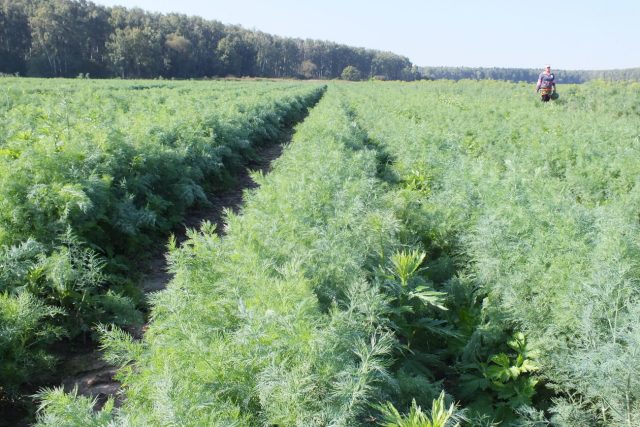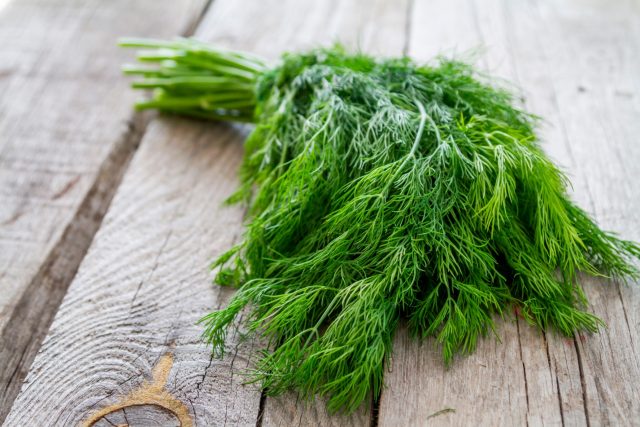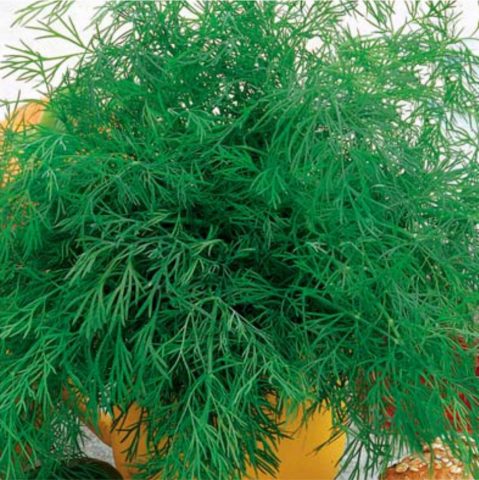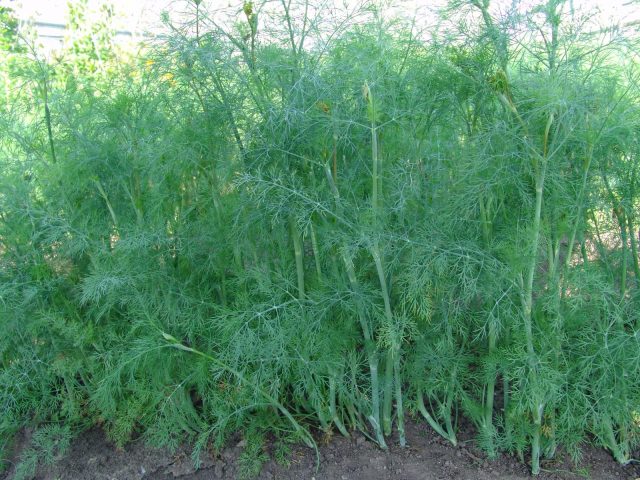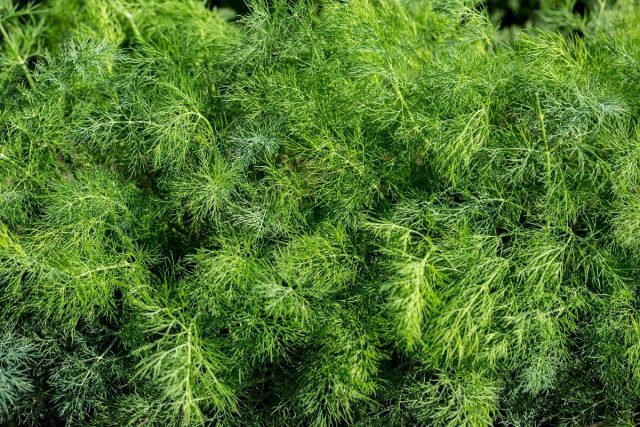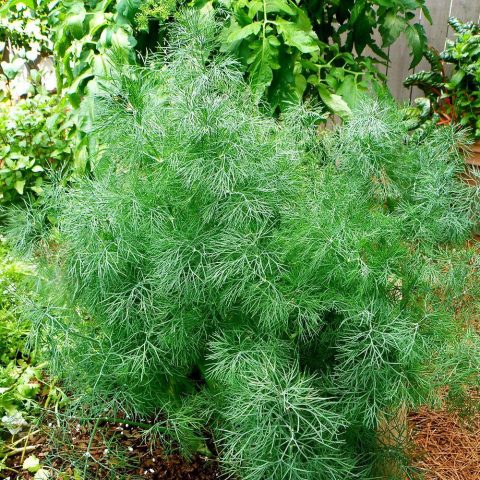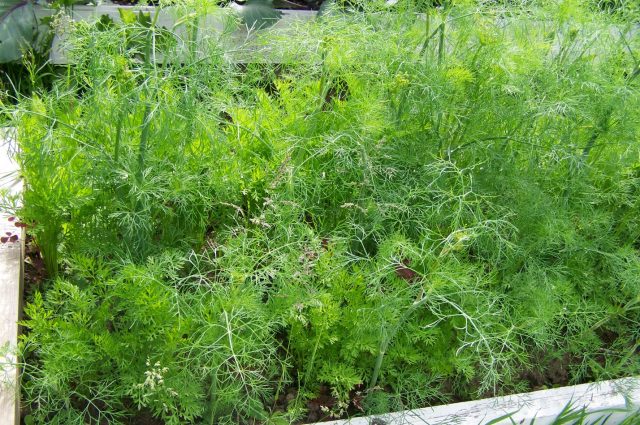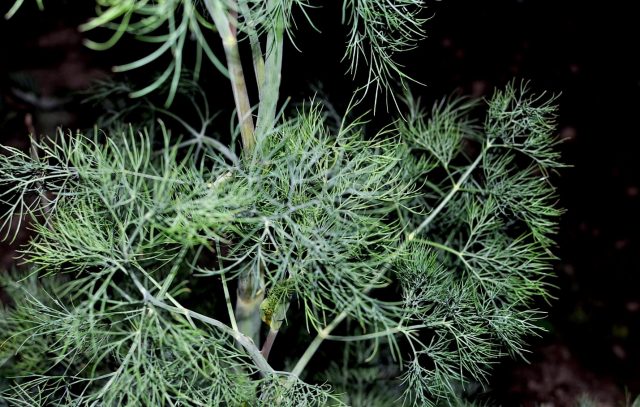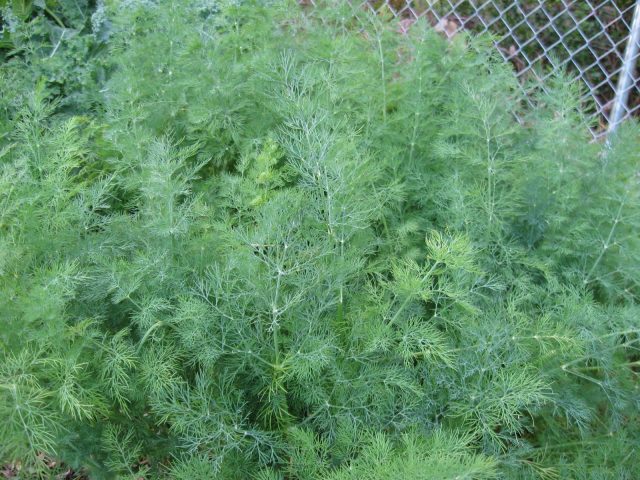Content
Bush dill and dill grown for greens differ in terms of ripening and cultivation conditions. There are greenhouse varieties that can be grown on a windowsill in indoor conditions and varieties for open ground.
What is the difference between bush dill
Bush dill (pictured) is an annual herb grown as an aromatic herb. Leaves are used in cooking, and inflorescences are used for conservation. Shrub dill is a frost-resistant plant that does not respond to a drop in temperature at night. Drought resistance of the culture is low, with insufficient air humidity and lack of irrigation, the vegetation slows down. The optimal condition for growth in an open area is a periodically shaded place, the air temperature is not higher than +22 0C.
A feature of bush dill is the late flowering time, arrows are formed at the end of summer. In areas with a short summer, the seeds of the culture cannot be collected, since they do not have time to ripen before frost.
External characteristics of bush dill:
- The height of the plant depends on the variety, on average, in an open area it reaches 1.5 m. Varieties intended for greenhouses - up to 2.5-3 m.
- The plant is sprawling, the appearance of the bush is created by additional leafy shoots that form from the axillary sections of the main leaves.
- In the lower part of the internodes are densely located, form a rosette, the leaves are large, openwork, together with the handle reach 45 cm, the indicator is conditional, the length depends on the variety.
- Forms 3-4 upright, hollow stems branched to the apex. The surface is finely furrowed with a gray waxy bloom, glossy, without edges, a dark green shade.
- The leaves are pinnately dissected, one tone darker than the color of the stems.
- Inflorescences are umbellate, radial, flowers are small, dark yellow in color.
- Seeds are ovoid, reaching 4 mm in length, dark gray or light brown.
The benefits of growing bush dill
The main advantage of bush dill is its intense foliage, unlike ordinary dill, its productivity is much higher. The flowering time is long, so the green mass remains until late autumn. The leaves of ordinary dill are cut young, the plant quickly forms stems and inflorescences, after flowering the leaves turn yellow and lose their economic value. In a bush plant, stem formation is slow, the concentration of essential oils is higher, they gradually accumulate over a long growing season. Therefore, judging by the reviews of those who sowed bush dill, the aroma of the leaves is richer.
The yield of bush dill
Ordinary dill planted on greens is harvested from the root, the next batch is sown in the vacant space. The process is laborious, the consumption of planting material is high. Bush dill saves seeds and gives no less yield.
The plant forms young shoots with leaves throughout the growing season. Several inflorescences are left on the seeds, the rest are removed as they grow. The plant spends nutrients on the leaves. For a family of 5, 13 dill bushes are enough to have greens in the diet until autumn.Bush crop yield from 1 m2 is approximately 2.5-8.5 kg, depending on the variety.
The best varieties of bush dill for greens
The culture has several varieties with different ripening periods, bush height and degree of foliage. The varieties differ in the method of cultivation, some of them are intended for an open area, special varieties of dill for a temperate climate have been bred, they are cultivated only in a greenhouse. A description of the best varieties of bush dill will help determine the choice of planting material.
Early varieties
According to gardeners, it is better to plant an early variety of bush dill before winter, then in early spring the plant is ready for cutting. The cultivars quickly form leaves and an arrowhead with an inflorescence. The material is used to obtain the first greens; by the middle of summer, the dill is ready to use for conservation.
Gourmet
The dill variety Gourmet belongs to frost-resistant, tolerates a drop in temperature to -2 0C. Designed for cultivation by a protected method in Central Russia. In the South, dill is cultivated in open areas. Gourmet is a representative of a variety of low-growing bush dill. Plant height - 30-35 cm. The foliage is intense, the leaf plate grows up to 20 cm long. It grows quickly, the first greens are cut in early May. The productivity of the culture can be extended by the timely removal of the inflorescences. This is one of the few bush varieties that is sown several times per season.
Green herringbone
Dill Green herringbone reaches its economic usefulness in 25-30 days after germination. Seeds are sown before winter or early spring, at the beginning of May the plant gives the first greens.
The culture is high-yielding, densely leafy, reaches a height of 50-75 cm. The leaves are long, light green, juicy, do not turn yellow at low humidity. Grow the Green Herringbone for herbs and spice. Sowing can be done throughout the summer with an interval of 15 days. The variety is suitable for commercial cultivation in greenhouse structures and outdoors.
Mid-season varieties
Young shoots of mid-season varieties reach economic suitability in 30-45 days, before the flowering period is 65-70. Dill slowly forms stems and forms inflorescences. Harvesting green mass takes much longer than early maturing varieties.
Buyan
Dill Buyan is suitable for growing in any way. The high-yielding low-growing crop reaches a height of 60 cm. The leaves are long, coarsely dissected, dark green with a waxy bloom.
Forms young shoots with leaves throughout the season. Grown for greens. The yield of the variety is up to 5 kg from 1 m2, the green mass of one bush is 250 g. The plant tolerates dense planting, partial shade, and a drop in temperature. Suitable for greenery.
Amazon
According to the reviews of gardeners and the description for the variety, Amazon dill is the most frost-resistant and undemanding representative of the culture. The plant is planted in an unprotected bed in early spring after the snow melts. In early June and until the end of September, they are harvested. They are sown in the greenhouse before winter.
The bush grows up to 1 m, during the summer it intensively forms numerous shoots from the leaf sinuses. Productivity - 4.5 kg from 1 m2... The plant is versatile in use, goes for greens, lends itself well to freezing and drying. Forms inflorescences in early September, they are used for marinade.
Goblin
Bush dill Leshy, according to the reviews of those who planted the plant, is a productive variety of culture. A sprawling, tall bush constantly forms new shoots, in an open garden it grows up to 2 m, in a greenhouse - up to 3.5 m. Good foliage provides a high yield. For the season from 1m2 cut off up to 9 kg of greens.
The leaves of the plant are large, dark green, juicy, with a high content of essential oils. The first cut is carried out in early June from the lower leaves, the last in mid-September. In the Northwest regions, the culture does not have time to form inflorescences.
Herringbone
Shrub dill Herringbone, according to gardeners, refers to a stunted, but rather productive variety. The growing season is about forty days. The low growth of the shrub compensates for the density of foliage, due to the shortened internodes.
The yield is 2.5-3 kg from 1 m2... The leaves are large, finely dissected, dark green with a gray bloom. Cutting is carried out from the lower leaves. The plant is demanding on soil fertility and constant watering. Harvesting is carried out from June to August.
Late ripening varieties
Late varieties of bush dill are grown for greens in greenhouses and in an unprotected area. A distinctive feature of the plant is the slow formation of inflorescences. Many of them do not have time to form umbrellas before the onset of frost, so they are mistakenly classified as umbrellaless species.
Bush miracle
Dill Bush miracle is intended for growing in a temperate climate zone.
The plant is bred in seedlings, both in a greenhouse and in an open garden. Description:
- height - up to 1.1 m, volume - 50 cm;
- leaves are dark green, strongly dissected, with a high concentration of essential substances;
- stem erect, intensely leafy;
- has a high immunity;
- yield - 5.5 kg / 1 m2.
Fireworks
Description of the variety of dill Fireworks:
- the bush is formed by four shoots growing from the outlet node, height - 70-95 cm;
- the ripening period of greens is 35-40 days;
- before the formation of umbrellas - 60 days;
- leaves are dark green with a waxy bloom;
- high foliage.
Greens are cut from June to August. Productivity - 2.5-3 kg from 1 m2.
Russian size
According to gardeners, the strong point of bush dill Russian size is the high concentration of spicy substances. The foliage of the bush is good, but you can't call it high.
Plant height - 90 cm, in a greenhouse - 1.1 m, yield - 3 kg / 1 m2... The culture is light-loving, demanding for watering. The socket is powerful, branched. The leaves are small, finely dissected. The culture of universal use is grown in an open garden and in a greenhouse.
Moravan
Dill Moravan (pictured) is the most popular dill in a temperate climate. The plant is frost-resistant, does not require special lighting, can grow in partial shade. Dill is intended only for greenhouse cultivation. The plant is tall - up to 1.5 m, intensely leafy.
The leaves are large with a high concentration of essential oils, dark green with a blue tint. Grown only for greens, the duration of the collection is from June to August. Productivity - 4 kg from 1 m2.
Tetra
The variety is grown only for greens. According to gardeners, dill Tetra is a high-yielding plant.
It grows up to 60 cm, the bush is dense, compact, the rosette is powerful, dill is formed by 4-5 stems. The leaves are large, strongly spicy, green, without a waxy coating. Grown in a greenhouse, in an unprotected area, on a windowsill in room conditions. The collection of leaves is long from May to September. The growing season is 115 days. Arrow formation later, flowering in the open field does not occur. Productivity - 2.5-3 kg / 1 m2.
Features of growing bush dill
According to gardeners, to obtain a high yield, bush dill is sown before winter. The culture is more whimsical to care for than conventional varieties. For growing in a greenhouse, you need to take care of installing additional lighting so that daylight hours are at least 13 hours.
Agrotechnics:
- Soils for the plant are suitable for neutral or slightly alkaline, light, pre-enriched with micronutrients.
- After germination, the plant is thinned out, a distance of 30 cm is left between the culture.
- They are fed with organic matter with an interval of 25 days, and urea is added.
- The inflorescences are removed.
- Watering is carried out 2 times a week - 7 liters per 1 m2.
- Tomatoes, carrots, fennel are not placed next to dill, in the latter cases, the culture is re-pollinated, the seeds lose varietal qualities.
Conclusion
Bush dill appeared relatively recently on the seed market. It is a high-yielding crop with a high chemical content of essential oils. The plant is represented by numerous varieties with different ripening times and rosette heights.
